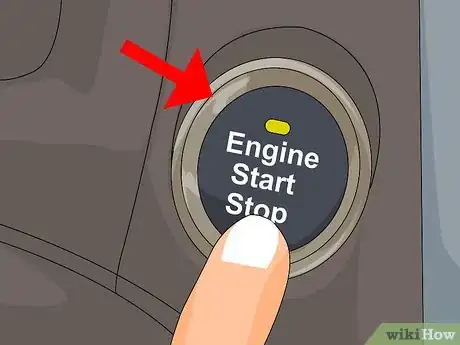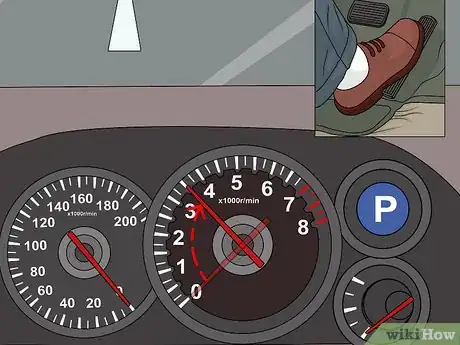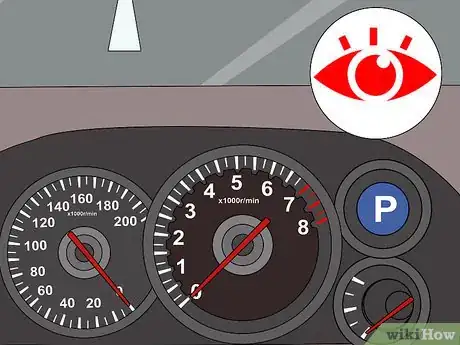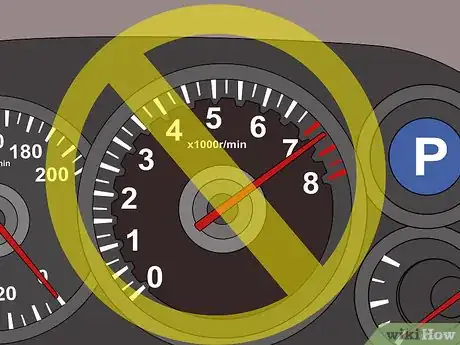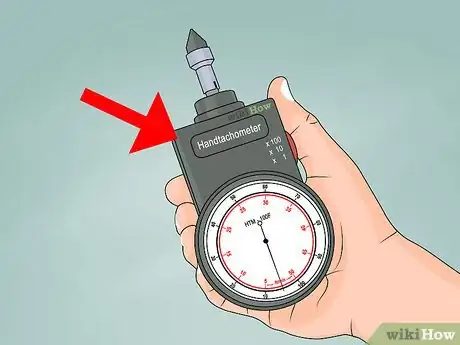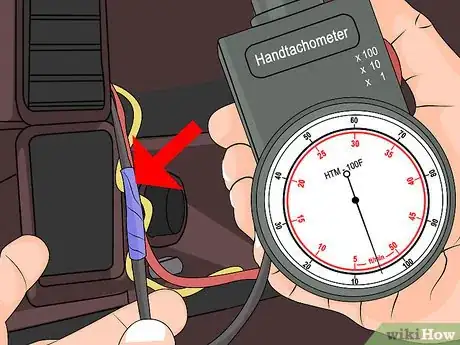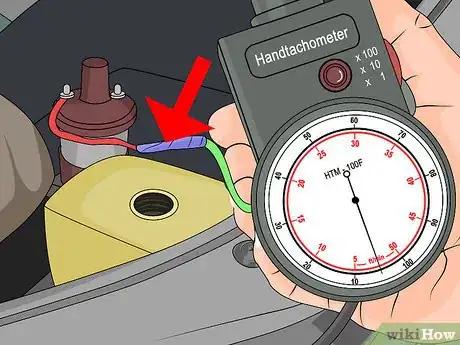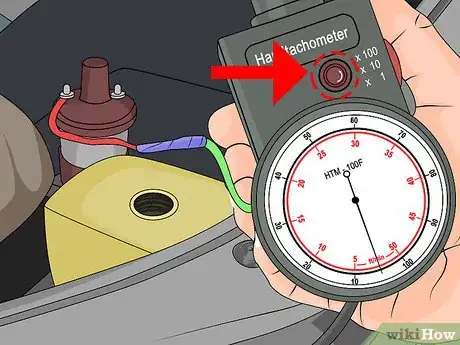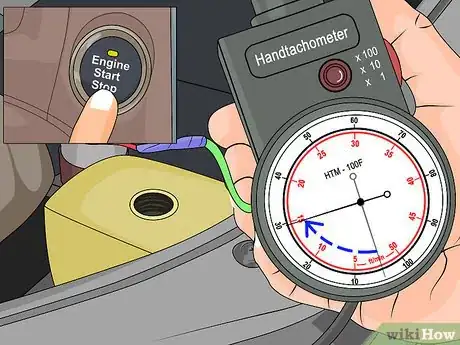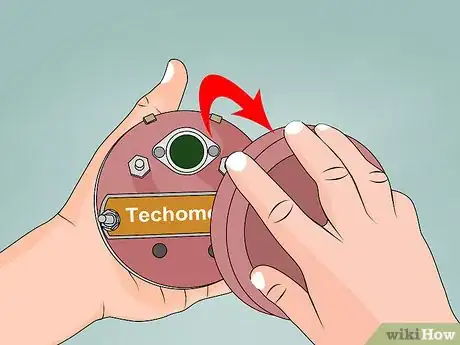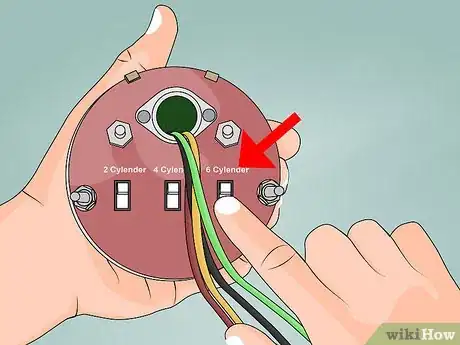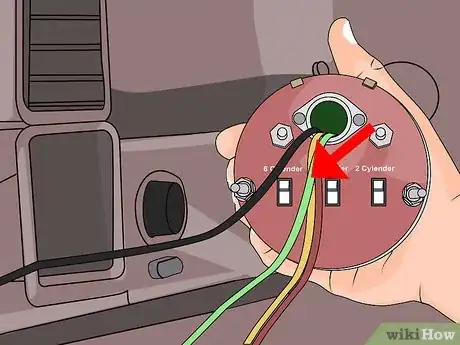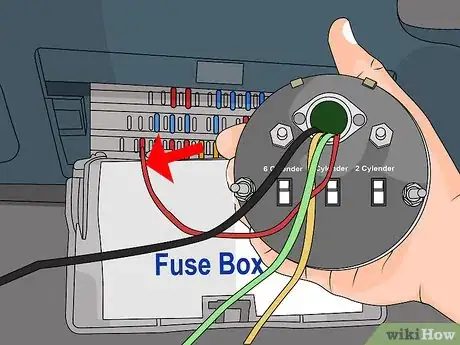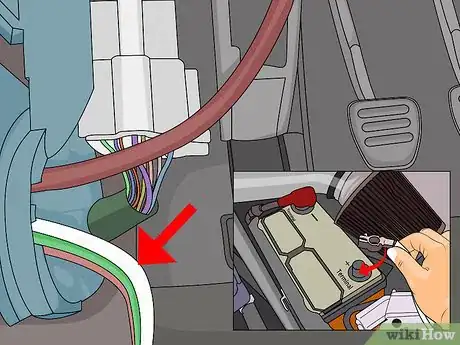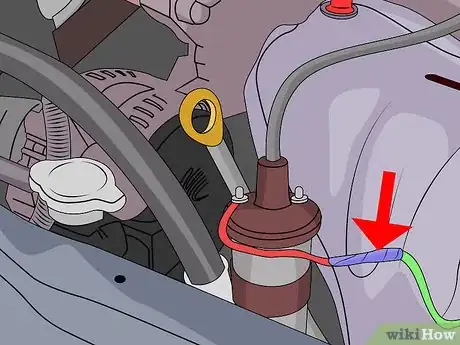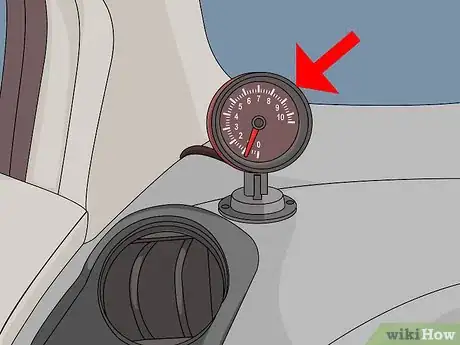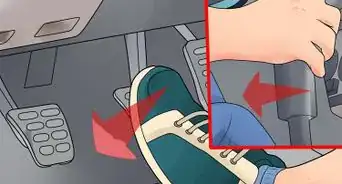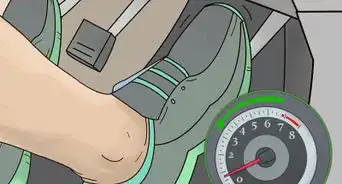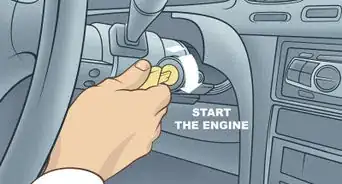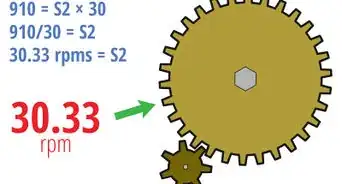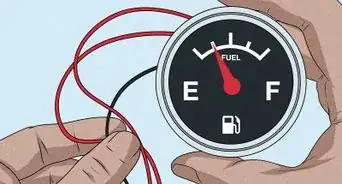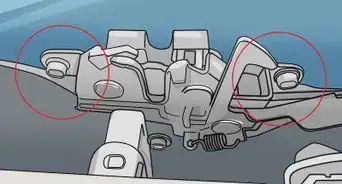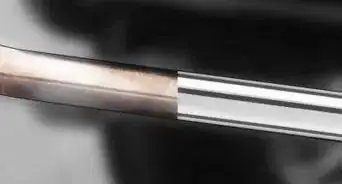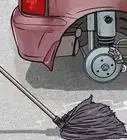This article was co-authored by wikiHow Staff. Our trained team of editors and researchers validate articles for accuracy and comprehensiveness. wikiHow's Content Management Team carefully monitors the work from our editorial staff to ensure that each article is backed by trusted research and meets our high quality standards.
This article has been viewed 59,611 times.
Learn more...
RPM stands for Revolutions Per Minute. RPMs serve as a way to measure how hard your engine is working. While most vehicles come equipped with a tachometer, some may not. You may need to install an aftermarket tachometer in order to read RPMs while driving. If you need to measure the RPMs of your vehicle to help diagnose an issue, you may choose to utilize a handheld tachometer that can measure the vehicle’s RPMs while you work under the hood.
Steps
Using the Vehicle’s Tachometer
-
1Identify the tachometer before driving. Get into the driver’s seat of the vehicle and take a good look at your gauges. Most vehicles come equipped with a speedometer, fuel gauge, coolant temperature gauge and a tachometer. They may be arranged in a number of ways depending on the make and model of your vehicle.[1]
- The tachometer usually shows single or double digit numbers that increase into a red band, which shows RPMs above the redline for the vehicle.
- The redline is the highest number of RPMs your vehicle can manage safely.
-
2Start the vehicle. With a good understanding of where to find each gauge, press the brake pedal with your right foot and turn the key in the ignition to start the vehicle. You’ll notice the tachometer climbs rapidly, before settling on the number of RPMs your vehicle idles at.[2]
- Idling is when the engine is running without any fuel input from the driver.
Advertisement -
3Press the gas pedal and note its effect on the tachometer. With the vehicle in park (or neutral with the parking brake engaged) press your foot on the gas pedal and observe the tachometer. As you increase the amount of gas going into the engine, the RPMs climb to match.[3]
- Getting a sense of how quickly your engine revs will help make driving a standard vehicle easier.
- If you were unsure which gauge was the tachometer, this will help you identify it.
-
4Glance at the tachometer periodically while driving. If driving a vehicle equipped with a standard transmission, it’s important that you maintain a sense of how many RPMs the engine is at in each gear you are in. Glance at the tachometer frequently, just as you check each of your mirrors.[4]
- The tachometer will show you how many RPMs you are at in each gear, indicating when to switch to the next one.
- You should be checking your speed periodically as well, so glancing at the tachometer should be an easy addition.
-
5Avoid over-revving the engine. The red line on the tachometer represents the highest number of revolutions the engine is capable of withstanding safely. While you should never approach the red line in normal driving, you may occasionally when accelerating quickly. Shift into the next gear before exceeding the red line on your tachometer.[5]
- Spinning the engine at too many RPMs can cause serious internal damage.
Checking RPMs with a Mechanic’s Tachometer
-
1Purchase a handheld tachometer. A mechanic’s tachometer or handheld “tach-tool” looks like a multimeter or a volt gauge and can be purchased at most auto parts stores. Ensure you purchase a tachometer and not one of the other tools that look similar.[6]
- Some tools may have multiple functions. Ensure the tool you purchase includes tachometer among those functions.
-
2Ground the black lead from the tachometer. Open the hood of the vehicle and connect the black lead coming out of the tachometer to the negative terminal on the battery or any bare metal on the body of the vehicle.[7]
- Ensure the ground wire is connected firmly and won’t come loose while the engine starts.
- Be sure the wire won’t get caught by any belts or other moving parts once the engine starts.
-
3Run the positive lead to the green wire on the ignition coil. The positive lead from the tachometer will be red. It must be connected to the ignition coil to read the signals it sends and translate that into RPMs. If you do not wish to splice the wire for this temporary reading, insert an unfolded paper clip into where the green wire connects to the ignition coil, then clip the lead onto the paper clip.[8]
- Ensure the lead has a solid, metal on metal connection so it can read the signals coming from the ignition coil.
-
4Set the tachometer for the number of cylinders. Turn the dial on the tachometer to the number of cylinders in your engine. Most handheld tachometers have a knob on the front of the device you simply turn until it points at the correct setting.[9]
- If you are unsure how many cylinders are in your engine, refer to the vehicle’s owner’s manual for guidance.
- If your vehicle came equipped with a five, ten or twelve cylinder engine, ensure you purchase a tachometer that can support that.
-
5Start the engine and read the screen on the tachometer. While holding the tachometer, ask a friend to get into the vehicle and turn the key in the ignition. Once the engine starts, the tachometer will begin displaying the number of RPMs the engine is running at.[10]
- Some tachometers list single digits that represent thousands of RPMs, others show double digits that represent hundreds of RPMs or three digits that show tens of RPMs.
- Refer to the package for your tool to know for sure which your tachometer displays.
- Do not drive the vehicle using this form of tachometer. It is only effective for engine diagnostics and diagnosis.
Installing an After-Market Tachometer
-
1Remove the tachometer housing. The back of the tachometer is encompassed in a housing that is sometimes referred to as a “cup.” This cup can be removed by either twisting it off the tachometer or by removing a single screw on the bottom or top, depending on the brand of tachometer.[11]
- Make sure you don’t lose the screw if your tachometer comes equipped with one, as you’ll need it to put the tach back together.
- Refer to the instructions that came with your tachometer if you are having trouble determining how to remove the housing.
-
2Set the tachometer for the number of cylinders in your engine. There are a series of switches on the back of the tachometer once the housing is removed. These switches set how many cylinders there are in the engine so the tachometer can understand the signal from the ignition coil. Set the switches to match your vehicle’s engine.[12]
- Most tachometers have the switches labeled, so it’s easy to determine which to turn on for four, six and eight cylinder applications.
- If the switches are not labeled, refer to the instructions that came with the tachometer to set the switches properly.
- Put the housing back on the tachometer once you have the engine setting set.
-
3Ground the black wire. The wires coming out of the back of the tachometer are color coded to make it easy to determine where each wire should go. Run the black wire from the tachometer to a ground. You may choose to run it through the firewall on the vehicle to the negative terminal on the battery. You can also wire it to any bare metal portion of the body of the vehicle.[13]
- The ground wire is one of two required in order to complete the electrical circuit.
- You may choose to wrap the wire around a bolt and tighten it or solder it in place.
-
4Connect the red wire to a fused switch. The red wire provides the tachometer with power when the vehicle is running. Use an “add-a-fuse” or fuse pigtail to connect this wire to a fuse that powers something that only operates when the vehicle is running, such as the interior lights or radio.[14]
- Locate the fuse box on the driver’s side of the interior of the vehicle.
- Remove the fuse and insert the fuse pigtail in a similar fashion to when replacing a blown out fuse.
-
5Run the white wire to a constant power source. The white wire coming from the back of the tachometer must be connected to a constant power source. Run it through the hole in the firewall separating the engine from the cabin of the vehicle. The easiest place to do so may be in the holes the gas, brake and clutch pedal pass through the firewall. Once through, connect this wire to the positive terminal on the battery.[15]
- It may be difficult to run the wire through the hole in the firewall. Use a flashlight to help locate the hole below the dashboard.
- Insert the wire into the pigtail that attaches to the positive terminal on the battery so it is easy to disconnect with the battery.
-
6Connect the green wire to the ignition coil. The green wire will also need to run through a hole in the firewall and to one of the ignition coils in your engine. Locate the ignition coil by following the spark plug wires backward from the spark plugs. The coil will have three wires coming from it. Splice the green wire from the tachometer into the green wire on the ignition coil.[16]
- This wire transmits the RPM information to the tachometer when the engine is running.
- Be sure the wire is not run over any moving parts that may snag it when the engine is running.
-
7Mount the tachometer. Use the screws that came with the tachometer to mount it someplace visible to you, but that won’t impede your vision while driving. A common location is on the side of the dash board near the A-pillar.[17]
- Special gauge pods can be purchased to help mount the gauge in a visually pleasing way.
- Tuck all of the wires so they are no longer visible.
Community Q&A
-
QuestionMy RPMs stay below 1,000 when idling, but my husband says it should be higher. Is something wrong?
 Community AnswerNo. Not all engines idle at the same number of revolutions per minute. The RPMs should climb while driving, but there is no issue with a vehicle idling at below 1,000 RPMs.
Community AnswerNo. Not all engines idle at the same number of revolutions per minute. The RPMs should climb while driving, but there is no issue with a vehicle idling at below 1,000 RPMs. -
QuestionHow to refill coolant?
 Community AnswerWait until the engine is cold, then open the radiator and fill entirely. Add some coolant to the overflow container as well.
Community AnswerWait until the engine is cold, then open the radiator and fill entirely. Add some coolant to the overflow container as well.
References
- ↑ http://www.driversedguru.com/driving-articles/car-auto-maintenance/yes-those-gauges-on-your-dash-are-important/
- ↑ http://www.driversedguru.com/driving-articles/car-auto-maintenance/yes-those-gauges-on-your-dash-are-important/
- ↑ http://www.driversedguru.com/driving-articles/car-auto-maintenance/yes-those-gauges-on-your-dash-are-important/
- ↑ http://www.driversedguru.com/driving-articles/car-auto-maintenance/yes-those-gauges-on-your-dash-are-important/
- ↑ http://www.driversedguru.com/driving-articles/car-auto-maintenance/yes-those-gauges-on-your-dash-are-important/
- ↑ https://www.youtube.com/watch?v=p41D1RjSMvU
- ↑ https://www.youtube.com/watch?v=p41D1RjSMvU
- ↑ https://www.youtube.com/watch?v=p41D1RjSMvU
- ↑ https://www.youtube.com/watch?v=p41D1RjSMvU
- ↑ https://www.youtube.com/watch?v=p41D1RjSMvU
- ↑ http://www.offroaders.com/tech/Autogage-Tachometer.htm
- ↑ http://www.offroaders.com/tech/Autogage-Tachometer.htm
- ↑ https://www.autometer.com/media/manual/2650-1244.pdf
- ↑ https://www.autometer.com/media/manual/2650-1244.pdf
- ↑ http://www.offroaders.com/tech/Autogage-Tachometer.htm
- ↑ http://www.offroaders.com/tech/Autogage-Tachometer.htm
- ↑ https://www.autometer.com/media/manual/2650-1244.pdf

